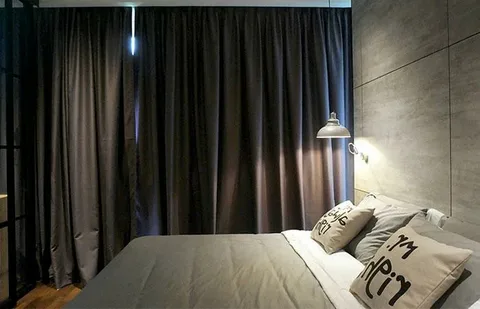Covering the window with a curtain that carries lining, ultimately enhances the style of your interior. Curtain lining is basically the addition of an extra layer for multipurposes. In this article, we have described some unique aspects of different lining options for window curtains. By considering our facts, you will be able to choose the right option for your window covering. Aside from this, we have described the best techniques to line curtains.
Incredible Lining Options For Window Curtains
An appropriate curtain lining offers a wide range of functional and aesthetic benefits such as insulation, noise reduction, and block light and view from the outside. The lining effects in curtains come with different fabrics, colors, and pattern options. The multiple lining options for curtains have been described to make your window more functional.
- Blackout Lining
- Thermal Lining
- Interlining
- Plain Lining
- Decorative Lining
Blackout Lining
To get the maximum effect from blackout curtain lining, we can consider multiple material, color, and texture options. Polyester, cotton, velvet, and heavy microfiber are the most commonly use to add blackout lining in window curtains. However, blackout lining also adds multiple features to your window covering such as energy efficiency, light blocking, privacy enhancement, and noise reduction. The blackout curtains in Dubai provides complete darkness and privacy by blocking the tiny pores in the fabric weave.
Thermal Lining
As the name suggests, thermal lining plays an important role in regulating the inside temperature. Its unique fabric texture and lining assist in maintaining the temperature in summer or winter, hence improving the energy efficiency of the home. Chenille, polyester, velvet, cotton, silk, and wool are the best fabric choices for crafting curtains’ thermal lining. Basically, three pile layers are blended together to create a thermal lining effect in curtains.
Interlining
For creating an interlining effect in the window curtains, lightweight and soft textured fabrics are highly recommended such as cotton, silk, polyester, and linen. In this type, an extra layer is submerged between the face fabric and lining, hence providing a required interior appearance.
The addition of an extra layer ultimately enhances the weight and thickness of lightweight curtain fabric. Interlining curtains are a versatile blend of traditional and modern designs. Moreover, this lining option will be helpful to reduce the unnecessary sound due to its extra fabric layering.
Plain Lining
The plain lining is the most classical style for window curtains with plain fabrics. In this lining option, cost-effective materials of light colors are usually used. This lining gives warmth and privacy to some extent but enhances the thickness of the curtains. If you want to keep your place’s window styling decent, the plain lining is a great option.
Decorative Lining
The decorative lining option is used to draft a new curtain’s look and style. In this lining, multiple textures, colors, and patterns are employed to create a versatile curtain ambiance. A broad range of solid and neutral color patterns can be considered to make perfect color contrast. In addition, this lining option also adds some stripes, and floral, geometric, or abstract patterns on the curtain surface to enhance its visual appearance.
Need Of Linings For Curtains
The need of linings for curtains depends upon personal desires, style, and needs. All types of curtains don’t require lining options but some curtains require. If you want to completely block the light and need full privacy, blackout lining is an excellent option for creating a dark effect. However, if you want to regulate the temperature inside the space, the thermal lining would be highly preferable.
Additional Guide On How To Line Curtains Effectively
Basically, there are two techniques to line curtains. We have given a basic overview of each technique.
Liner Attachment To Header Tape
- For this technique, you need to take accurate curtain measurements.
- After the curtains, also take the measurement of the liner by using tape and add 6cm extra in this measurement.
- Now cut the perfect-sized piece of lining fabric as per exact measurement.
- Take an exact-sized header tape and a piece of lining fabric to sew.
- After sewing both pieces together, attach them to the curtain by sliding hooks into header tape.
Sewing The Liner Fabric To Curtains
- In this technique, you need to detach all the hems from the curtain top, right, and left side.
- After removing hems, take measurements of the curtain.
- The next step is to precisely cut the lining fabric according to curtain measurements.
- Sew the lining fabric with curtains by placing them at appropriate positions.
- After sewing both pieces, you need to iron them to attach them tightly and remove wrinkles.
Conclusion
It is concluded that all lining options are unique and useful with their versatile functions and textures. Choosing the right lining option for curtains depends upon your desired features, style, and pattern. We have explained all the options individually, hence you can surely opt for the right option by following our effective discussion.
Furthermore, we have provided two basic guides to line curtains in detail. Try creating your desired window styling with lining options at home by following our this step-by-step guide.










